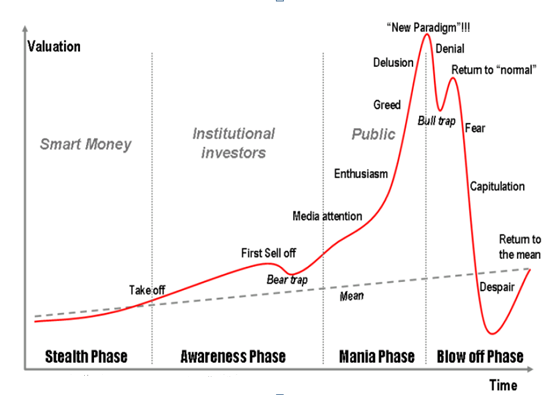
Interestingly, the chart above looks remarkably like the bubble real estate market created by Federal Reserve monetary policy between 2002 and 2007. You can see that at the link.
As I noted when I started this blog back in 2010, bonds are the current bubble, and all bubbles burst. Please read the entirety of Kerr's analysis which covers the factors quite thoroughly. Here is the conclusion -- emphasis added by me:
A forced liquidation of assets in the wake of a confidence crisis would obviously have dramatic impact on all the markets we have mentioned in addition to a multitude of others. We have shown that capital concentrations tend to build slowly but unwind swiftly. As such it is not beyond the realm of possibility that all gains seen over past 4 years in the bond and stock markets could be unwound in a very short period of time. Going back to the idea of the web of capital, the lynchpin looks to be the currency markets and specifically the US Dollar. With the Federal Reserve immersed in aggressive balance sheet expansion through the use of quantitative easing the Greenback has become a form of funding especially within the emerging markets through various official and unofficial pegs. At the behest of the Fed through its forward guidance, investors have borrowed these cheap dollar assets to invest in higher yielding non-dollar ones. Looking at the difference between the growth in FX reserves and cumulative current account surpluses we can estimate the rough size of the short USD carry trade. According to the most recent data it is at least around $2 trillion based on this metric! The whole trade, however, is built on the notion that the Fed and other central banks will continue with this policy into perpetuity. For this reason even [the] slightest realistic hint that the Federal Reserve is set to move away from ZIRP has the potential to unravel the whole thing. All those who have borrowed dollar assets will be forced to buy back their dollars forcing the currency higher – some 2 trillion USD worth! This de facto policy tightening would have grave and dramatic knock on effects for emerging and developed markets alike. Pay close attention to the dollar. Prolonged strength in the currency could the unexpected tail that prompts the beginning of the end in the latest central bank induced asset bubble.
The yen, the euro, and the dollar are all playing the same games. Despite the economic potential in the BRICs (Brazil, Russia, India, China), these are still relatively insignificant players on the financial side. They are all dependent on the flow of currency from, especially, the US as well as Japan and Europe.
I make no recommendations, but I will tell you my current status. I am mostly in cash. I even have a not insignificant deposit in the First Bank of BeautyRest. I still have some money in the markets, but it is money I can "afford" to lose. I fully expect to lose at least half of it. I have invested in what I think is essential to provide for my family in terms of tools and equipment and supplies.
It's hard to say what will happen with precious metals -- one would expect a price drop but it will be more severe in the "paper" versions than in the in-hand metal itself -- just as we saw earlier this year. But China and Germany, for example, will probably support a strong base for gold. Silver may take more of a hit because it is more of an industrial commodity. It might be a good time to buy more. Only the nominal, dollar-denominated value of these metals will decrease.
No comments:
Post a Comment